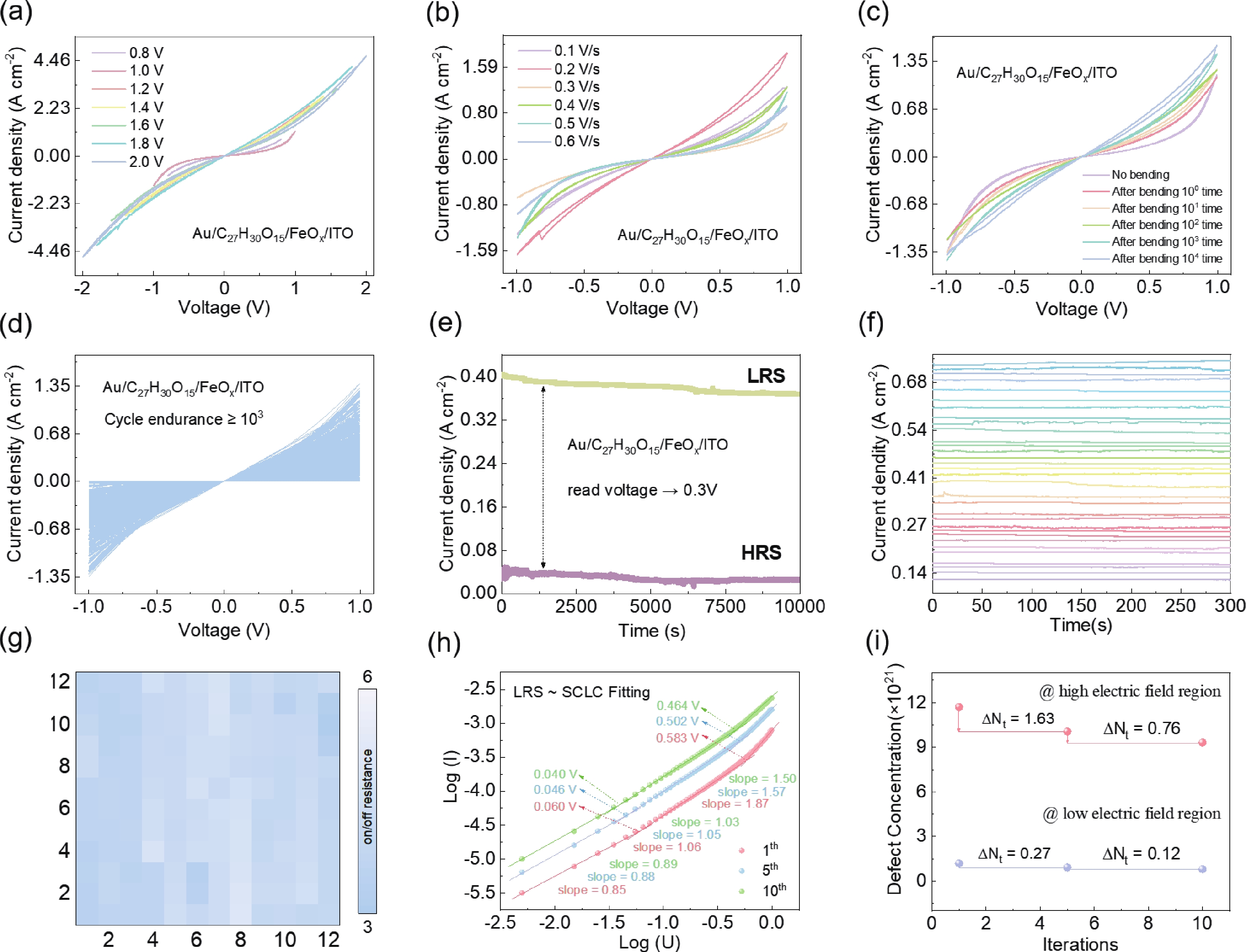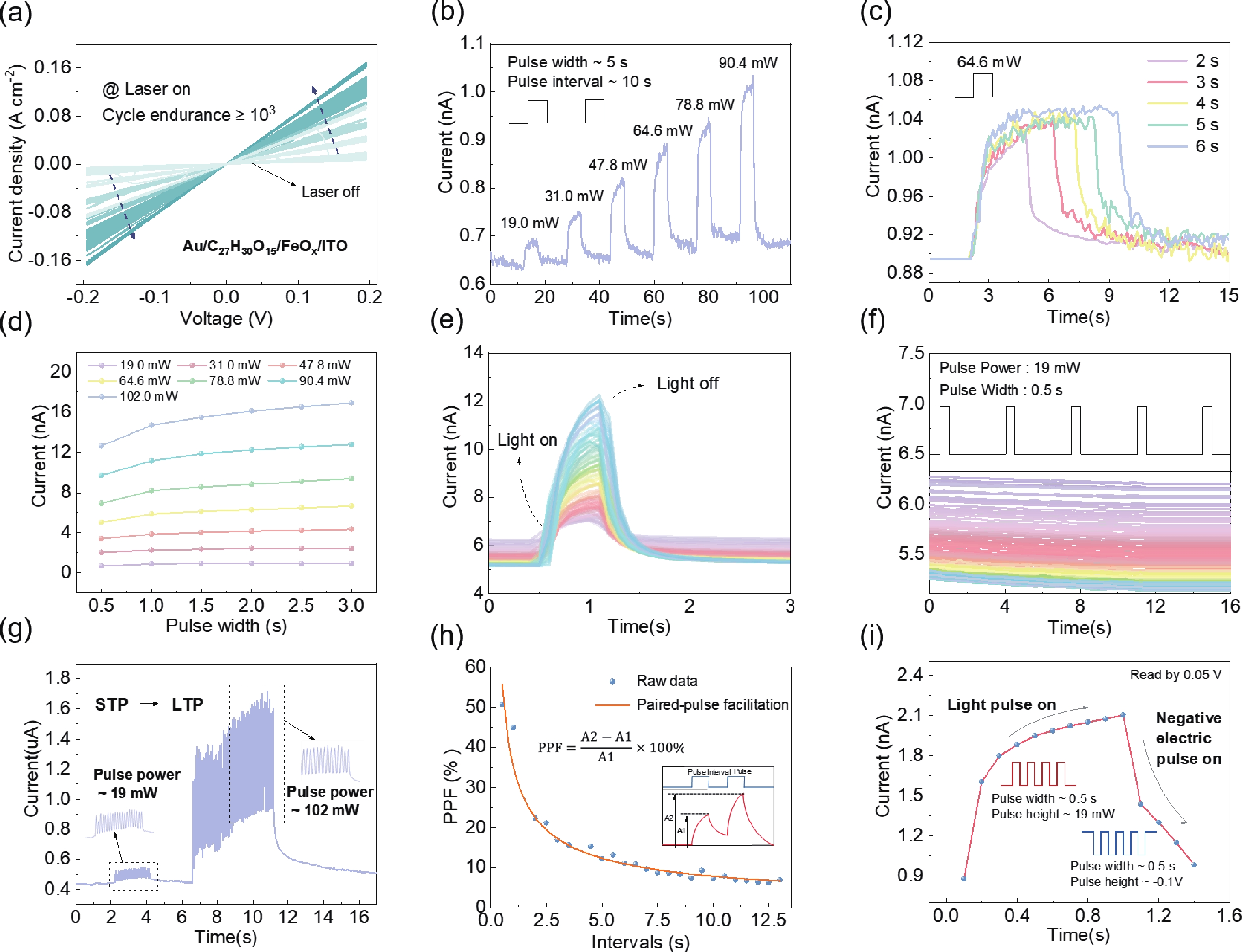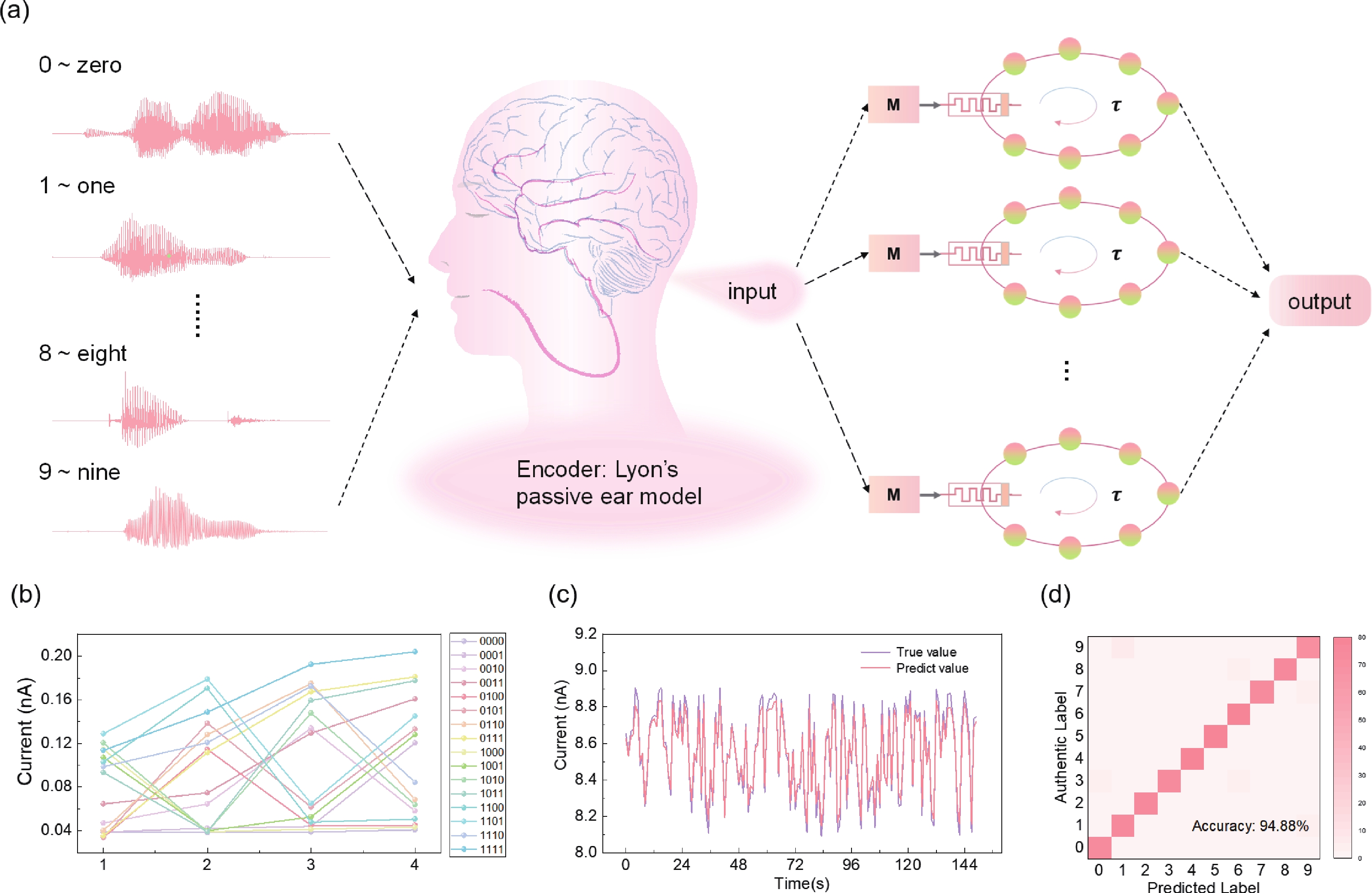| Citation: |
Jie Li, Yue Xin, Bai Sun, Dengshun Gu, Changrong Liao, Xiaofang Hu, Lidan Wang, Shukai Duan, Guangdong Zhou. Flexible artificial vision computing system based on FeOx optomemristor for speech recognition[J]. Journal of Semiconductors, 2025, 46(1): 012604. doi: 10.1088/1674-4926/24080004
****
J Li, Y Xin, B Sun, D S Gu, C R Liao, X F Hu, L D Wang, S K Duan, and G D Zhou, Flexible artificial vision computing system based on FeOx optomemristor for speech recognition[J]. J. Semicond., 2025, 46(1), 012604 doi: 10.1088/1674-4926/24080004
|
Flexible artificial vision computing system based on FeOx optomemristor for speech recognition
DOI: 10.1088/1674-4926/24080004
CSTR: 32376.14.1674-4926.24080004
More Information-
Abstract
With the advancement of artificial intelligence, optic in-sensing reservoir computing based on emerging semiconductor devices is high desirable for real-time analog signal processing. Here, we disclose a flexible optomemristor based on C27H30O15/FeOx heterostructure that presents a highly sensitive to the light stimuli and artificial optic synaptic features such as short- and long-term plasticity (STP and LTP), enabling the developed optomemristor to implement complex analogy signal processing through building a real-physical dynamic-based in-sensing reservoir computing algorithm and yielding an accuracy of 94.88% for speech recognition. The charge trapping and detrapping mediated by the optic active layer of C27H30O15 that is extracted from the lotus flower is response for the positive photoconductance memory in the prepared optomemristor. This work provides a feasible organic−inorganic heterostructure as well as an optic in-sensing vision computing for an advanced optic computing system in future complex signal processing. -
References
[1] Li C H, He Q G, Wang Y, et al. Highly robust and soft biohybrid mechanoluminescence for optical signaling and illumination. Nat Commun, 2022, 13(1), 3914 doi: 10.1038/s41467-022-31705-6[2] Zhang G X, Zhang Z C, Chen X D, et al. Broadband sensory networks with locally stored responsivities for neuromorphic machine vision. Sci Adv, 2023, 9(37), eadi5104 doi: 10.1126/sciadv.adi5104[3] Zhang C, Dasari D, Widmann M, et al. Quantum-assisted distortion-free audio signal sensing. Nat Commun, 2022, 13(1), 4637 doi: 10.1038/s41467-022-32150-1[4] Das T, Sharma B, Katiyar A, et al. Graphene-based flexible and wearable electronics. J Semicond, 2018, 39(1), 011007 doi: 10.1088/1674-4926/39/1/011007[5] Zhou G D, Sun B, Hu X F, et al. Negative photoconductance effect: An extension function of the TiOx-based memristor. Adv Sci, 2021, 8(13), 2003765 doi: 10.1002/advs.202003765[6] Miao Y, Wang Z R, Wei Z M, et al. Patterned growth of AgBiS2 nanostructures on arbitrary substrates for broadband and eco-friendly optoelectronic sensing. Nanoscale, 2024, 16(15), 7409 doi: 10.1039/D4NR00499J[7] Jiang X Y, Ye M R, Li Y H, et al. Multiframe-integrated, in-sensor computing using persistent photoconductivity. J Semicond, 2024, 45(9), 092401 doi: 10.1088/1674-4926/24040002[8] Shi L, Shi K, Zhang Z C, et al. Flexible retinomorphic vision sensors with scotopic and photopic adaptation for a fully flexible neuromorphic machine vision system. SmartMat, 2024, e1285 doi: 10.1002/smm2.1285[9] Zhou G D, Wang Z R, Sun B, et al. Volatile and nonvolatile memristive devices for neuromorphic computing. Adv Electron Mater, 2022, 8(7), 2101127 doi: 10.1002/aelm.202101127[10] Chai Y. In-sensor computing for machine vision. Nature, 2020, 579(7797), 32 doi: 10.1038/d41586-020-00592-6[11] Zhang Z H, Wang S Y, Liu C S, et al. All-in-one two-dimensional retinomorphic hardware device for motion detection and recognition. Nat Nanotechnol, 2022, 17(1), 27 doi: 10.1038/s41565-021-01003-1[12] Zhu Q B, Li B, Yang D D, et al. A flexible ultrasensitive optoelectronic sensor array for neuromorphic vision systems. Nat Commun, 2021, 12(1), 1798 doi: 10.1038/s41467-021-22047-w[13] Lee D, Park M, Baek Y, et al. In-sensor image memorization and encoding via optical neurons for bio-stimulus domain reduction toward visual cognitive processing. Nat Commun, 2022, 13(1), 5223 doi: 10.1038/s41467-022-32790-3[14] Wang C Y, Liang S J, Wang S, et al. Gate-tunable van der Waals heterostructure for reconfigurable neural network vision sensor. Sci Adv, 2020, 6(26), eaba6173 doi: 10.1126/sciadv.aba6173[15] Dodda A, Jayachandran D, Pannone A, et al. Active pixel sensor matrix based on monolayer MoS2 phototransistor array. Nat Mater, 2022, 21(12), 1379 doi: 10.1038/s41563-022-01398-9[16] Zhou G D, Li J, Song Q L, et al. Full hardware implementation of neuromorphic visual system based on multimodal optoelectronic resistive memory arrays for versatile image processing. Nat Commun, 2023, 14(1), 8489 doi: 10.1038/s41467-023-43944-2[17] Xu Y C, Shi Y M, Qian C, et al. Optically readable organic electrochemical synaptic transistors for neuromorphic photonic image processing. Nano Lett, 2023, 23(11), 5264 doi: 10.1021/acs.nanolett.3c01291[18] Dong X F, Sun H, Lai X H, et al. MoO x synaptic memristor with programmable multilevel conductance for reliable neuromorphic hardware. J Phys Chem Lett, 2024, 15(13), 3668 doi: 10.1021/acs.jpclett.4c00600[19] Zhou F C, Zhou Z, Chen J W, et al. Optoelectronic resistive random access memory for neuromorphic vision sensors. Nat Nanotechnol, 2019, 14(8), 776 doi: 10.1038/s41565-019-0501-3[20] Midya R, Wang Z R, Asapu S, et al. Reservoir computing using diffusive memristors. Adv Intell Syst, 2019, 1(7), 1900084 doi: 10.1002/aisy.201900084[21] Moon J, Ma W, Shin J H, et al. Temporal data classification and forecasting using a memristor-based reservoir computing system. Nat Electron, 2019, 2(10), 480 doi: 10.1038/s41928-019-0313-3[22] Sun L F, Hwang G, Choi W, et al. Ultralow switching voltage slope based on two-dimensional materials for integrated memory and neuromorphic applications. Nano Energy, 2020, 69(C), 104472 doi: 10.1016/j.nanoen.2020.104472[23] Gu L L, Poddar S, Lin Y J, et al. A biomimetic eye with a hemispherical perovskite nanowire array retina. Nature, 2020, 581(7808), 278 doi: 10.1038/s41586-020-2285-x[24] Wang W X, Gao S, Li Y, et al. Artificial optoelectronic synapses based on TiN xO2– x/MoS2 heterojunction for neuromorphic computing and visual system. Adv Funct Mater, 2021, 31(34), 2101201 doi: 10.1002/adfm.202101201[25] Sun L F, Wang Z R, Jiang J B, et al. In-sensor reservoir computing for language learning via two-dimensional memristors. Sci Adv, 2021, 7(20), eabg1455 doi: 10.1126/sciadv.abg1455[26] Wu X S, Wang S C, Huang W, et al. Wearable in-sensor reservoir computing using optoelectronic polymers with through-space charge-transport characteristics for multi-task learning. Nat Commun, 2023, 14(1), 468 doi: 10.1038/s41467-023-36205-9[27] Yang L B, Gu X S, Zhou M, et al. Deep-UV-photo-excited synaptic Ga2O3 nano-device with low-energy consumption for neuromorphic computing. J Semicond, 2024, 45(11), 1 doi: 10.1088/1674-4926/24050037[28] Wang Y C, Zhou G D, Sun B, et al. Ag/HfO x/Pt unipolar memristor for high-efficiency logic operation. J Phys Chem Lett, 2022, 13(34), 8019 doi: 10.1021/acs.jpclett.2c01906[29] Xiang S Y, Han Y N, Song Z W, et al. A review: Photonics devices, architectures, and algorithms for optical neural computing. J Semicond, 2021, 42(2), 023105 doi: 10.1088/1674-4926/42/2/023105[30] Wang Z R, Shen G Z. Flexible optoelectronic sensors: Status and prospects. Mater Chem Front, 2023, 7(8), 1496 doi: 10.1039/D2QM01319C[31] Zhu H, Shen Y, Li Y Q, et al. Recent advances in flexible and wearable organic optoelectronic devices. J Semicond, 2018, 39(1), 011011 doi: 10.1088/1674-4926/39/1/011011[32] Liao C R, Liu D, Liu Z, et al. Coexistance of the negative photoconductance effect and analogue switching memory in the CuPc organic memristor for neuromorphic vision computing. J Phys Chem Lett, 2024, 15(23), 6230 doi: 10.1021/acs.jpclett.4c01071[33] Wang W H, Zhou G D, Wang Y C, et al. Multiphotoconductance levels of the organic semiconductor of polyimide-based memristor induced by interface charges. J Phys Chem Lett, 2022, 13(42), 9941 doi: 10.1021/acs.jpclett.2c02651[34] Hou Y X, Li Y, Zhang Z C, et al. Large-scale and flexible optical synapses for neuromorphic computing and integrated visible information sensing memory processing. ACS Nano, 2021, 15(1), 1497 doi: 10.1021/acsnano.0c08921[35] Ren Z J, Wu J G, Liu H Y, et al. Competitive mechanism for capturing heavy metal contamination by iron-based porous composite particles for soil remediation. J Clean Prod, 2023, 424, 138896 doi: 10.1016/j.jclepro.2023.138896[36] Lyon R. A computational model of filtering, detection, and compression in the cochlea. ICASSP '82. IEEE International Conference on Acoustics, 1982, 1282 doi: 10.1109/ICASSP.1982.1171644 -
Proportional views





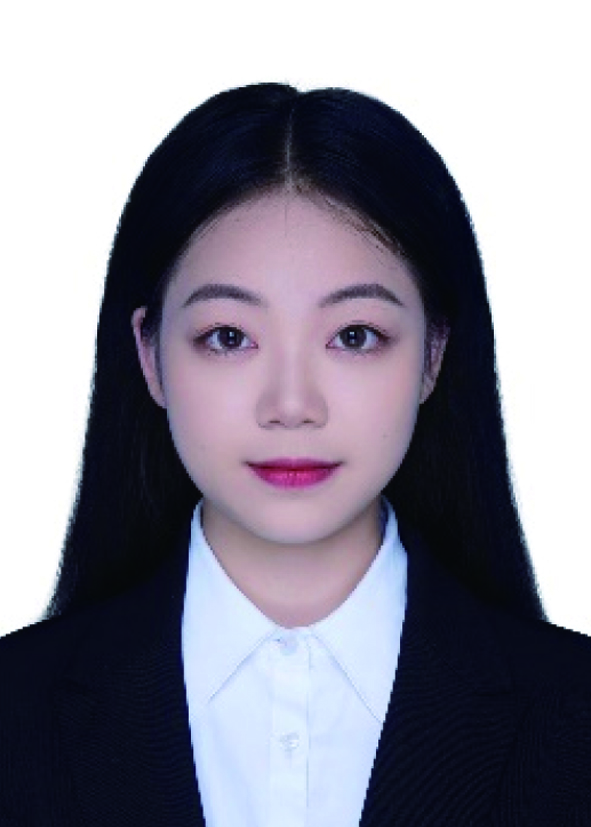 Jie Li obtained a Bachelor's degree in Intelligent Science and Technology from the School of Artificial Intelligence at Southwest University in 2024. She is currently pursuing an academic graduate degree in Computer Science and Technology at the School of Artificial Intelligence, Southwest University, under the guidance of Professor Zhou Guangdong.
Jie Li obtained a Bachelor's degree in Intelligent Science and Technology from the School of Artificial Intelligence at Southwest University in 2024. She is currently pursuing an academic graduate degree in Computer Science and Technology at the School of Artificial Intelligence, Southwest University, under the guidance of Professor Zhou Guangdong.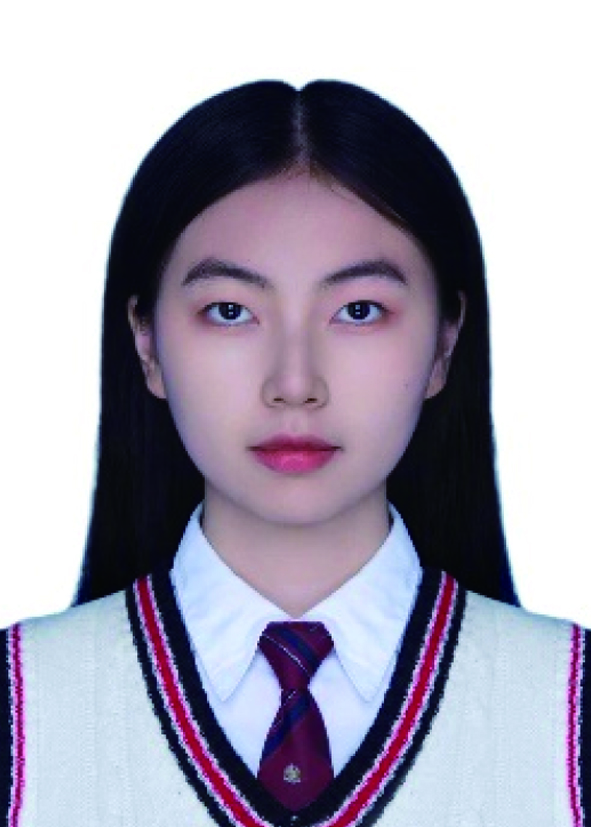 Yue Xin received her bachelor's degree from Southwest University in 2024. Her undergraduate major was Data Science and Big Data Technology. She is currently a graduate student of the School of Artificial Intelligence of Southwest University, under the supervision of Professor Zhou Guangdong.
Yue Xin received her bachelor's degree from Southwest University in 2024. Her undergraduate major was Data Science and Big Data Technology. She is currently a graduate student of the School of Artificial Intelligence of Southwest University, under the supervision of Professor Zhou Guangdong. Bai Sun obtained his doctoral degree in 2015. He is currently a professor and doctoral supervisor at Xi'an Jiaotong University. His primary research areas include artificial neural synapses, artificial neural networks, neurocomputational morphology, and neuromorphic chips. He has accumulated nearly 20 authorized patents and has led a total of 5 projects including National Natural Science Foundation projects.
Bai Sun obtained his doctoral degree in 2015. He is currently a professor and doctoral supervisor at Xi'an Jiaotong University. His primary research areas include artificial neural synapses, artificial neural networks, neurocomputational morphology, and neuromorphic chips. He has accumulated nearly 20 authorized patents and has led a total of 5 projects including National Natural Science Foundation projects.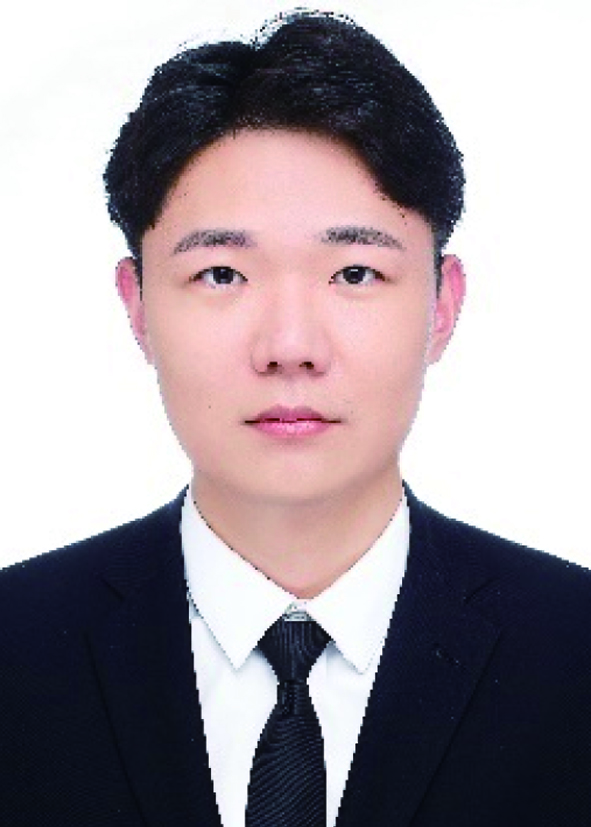 Dengshun Gu received the B.S. degree in information security from Anhui University of Science and Technology in 2022. He is currently pursuing a master's degree in Artificial Intelligence at Southwest University. His research interests include memristor device fabrication, algorithms and systems of memristors, and applications deployment of memristors.
Dengshun Gu received the B.S. degree in information security from Anhui University of Science and Technology in 2022. He is currently pursuing a master's degree in Artificial Intelligence at Southwest University. His research interests include memristor device fabrication, algorithms and systems of memristors, and applications deployment of memristors. Guangdong Zhou obtained his doctoral degree in 2018. Current professor and doctoral supervisor at Southwest University. Mainly engaged in the research of the theory, mechanism, integration, circuit system, and algorithm of the underlying core components of neuromorphic computing systems. He has published more than 70 SCI papers, and has led/presided over more than ten key projects of the National Natural Science Foundation of China and provincial-level natural science funds.
Guangdong Zhou obtained his doctoral degree in 2018. Current professor and doctoral supervisor at Southwest University. Mainly engaged in the research of the theory, mechanism, integration, circuit system, and algorithm of the underlying core components of neuromorphic computing systems. He has published more than 70 SCI papers, and has led/presided over more than ten key projects of the National Natural Science Foundation of China and provincial-level natural science funds.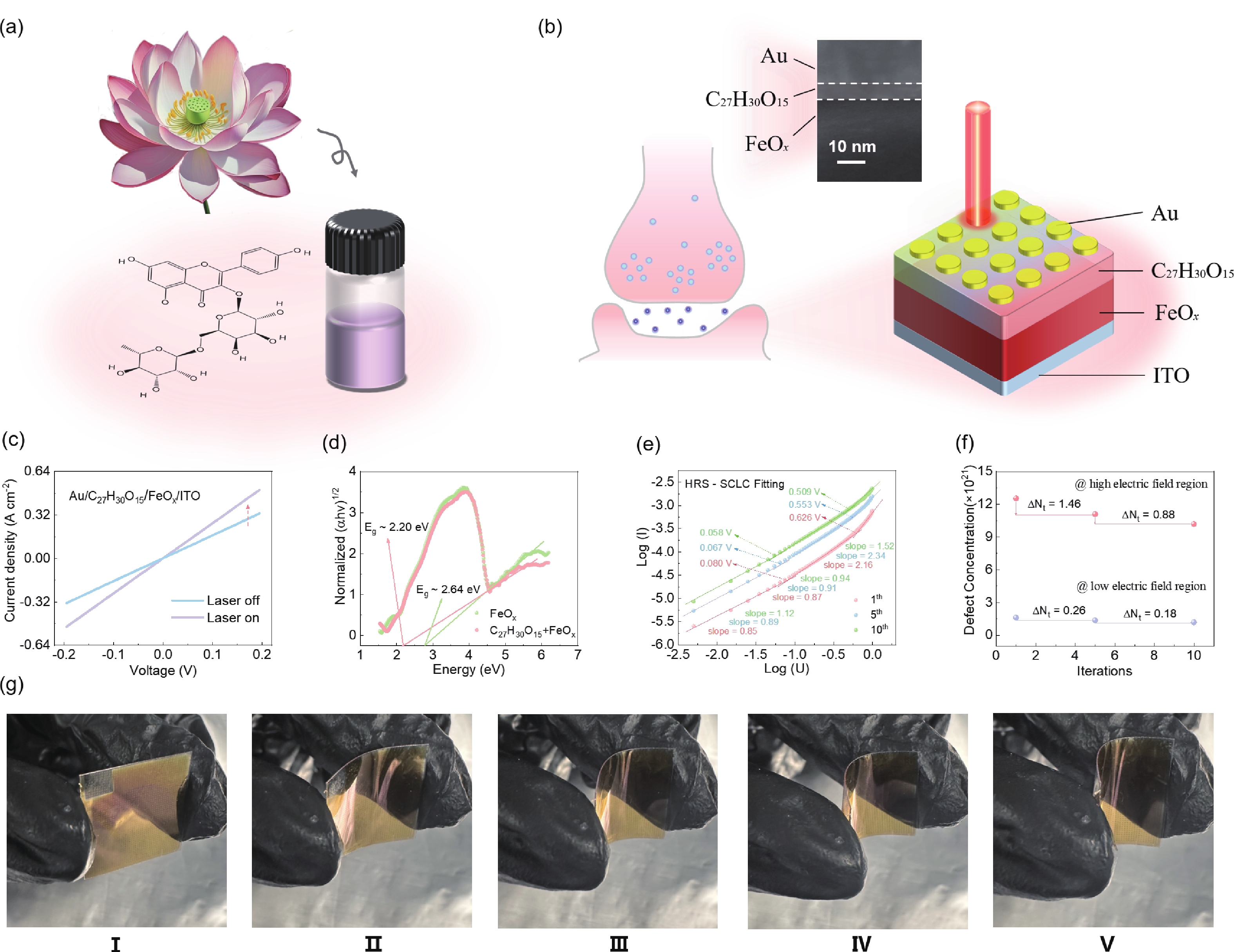
 DownLoad:
DownLoad:
